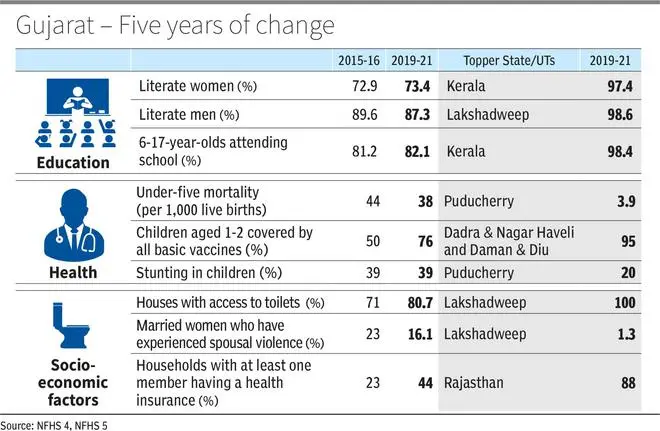With just days to go for State Assembly polls in Gujarat, how has the BJP’s bastion for nearly two decades fared in terms of health, education and socio-economic aspects in the last five years?
Data points from the National Family Health Surveys 4 and 5 suggest that the State has shown good improvement in health and socio-economic parameters, but there is still room for improvement compared with some of the best performing States and Union Territories (UTs).
Road to school
A majority of people in Gujarat are literate, like most Indian States. Between 2015-16 and 2019-21, Gujarat’s proportion of literate women has grown from 72.9 per cent to 73.4 per cent. This is definitely an improvement, but this isn’t much compared to Kerala (97.4 per cent), which is the topper here. However, when it comes to the proportion of literate men, Gujarat’s performance has dropped from 89.6 per cent in 2015-16 to 87.3 per cent in 2019-21.
On the other hand, the proportion of 6-17-year-olds who attend school has increased slightly from 81.2 per cent in 2015-16 to 82.1 per cent in 2019-21. Kerala again, tops this chart with 98.4 per cent.
Healthy ways
Child mortality has reduced in Gujarat under the current government. For every 1,000 live births in the State, 38 children die below the age of five, according to NFHS 5. In 2015-16, it used to be 44. While Gujarat’s score is lower than India’s national average (42 per 1,000 live births), there are many States and UTs faring much better. Puducherry has an under-five mortality rate of 3.9 and in Kerala, it is 5.2.
In the last half-decade, Gujarat made a huge jump in the proportion of 1-2-year-old children covered by all basic vaccinations. As of 2021, the proportion is 75 per cent, compared to 50 per cent in 2015-16. Gujarat’s score is, however, below the national average of 77 per cent. The toppers here are Dadra & Nagar Haveli and Daman & Diu with 95 per cent coverage and Odisha with 91 per cent coverage.

The State hasn’t made any progress over years when it comes to stunting in children with the proportion remaining unchanged at 39 per cent. Meanwhile, Puducherry has the lowest, albeit high, proportion of 20 per cent.
Only 80.7 per cent of Gujarat’s houses have toilet facilities. While it is an improvement from 71 per cent in 2015-16, Lakshadweep has achieved 100 per cent results in this area. Over 99 per cent of the houses in Kerala, Mizoram, Nagaland and Sikkim, too, have toilets.
The proportion of married women who have experienced spousal violence has dropped from 23 per cent in 2015-16 to 16.1 per cent in 2019-21 in Gujarat. The competition here, too, seems to be against Lakshadweep, where the proportion is just 1.3 per cent. While the western State did manage to achieve a lot over the last few years, it looks like the 15th Assembly will have a lot more to do to improve the health and welfare of people.





Comments
Comments have to be in English, and in full sentences. They cannot be abusive or personal. Please abide by our community guidelines for posting your comments.
We have migrated to a new commenting platform. If you are already a registered user of TheHindu Businessline and logged in, you may continue to engage with our articles. If you do not have an account please register and login to post comments. Users can access their older comments by logging into their accounts on Vuukle.